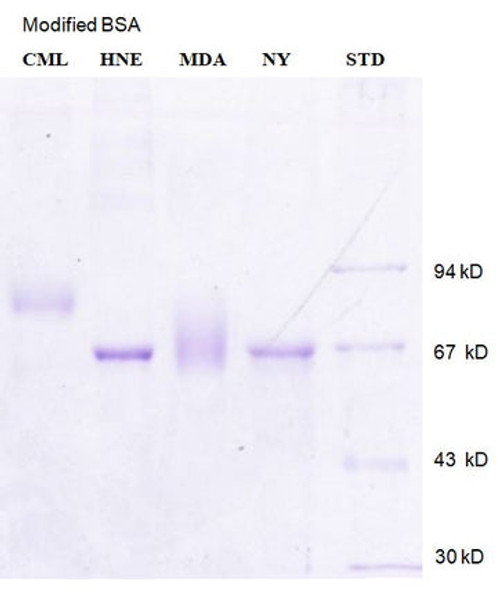Carboxymethyl-lysine modified Bovine Serum Albumin (CML-BSA), 50% glycerol | ABMC-P26
- SKU:
- ABMC-P26
- Availability:
- Usually shipped in 5 working days
Description
Carboxymethyl-lysine modified Bovine Serum Albumin (CML-BSA), 50% glycerol | ABMC-P26
| Concentration: | 1 mg / ml, determined by the Lowry method |
| Source: | Bovine Serum Albumin was purchased from Boehringer Mannheim and was modified by caboxymethylation to form CML modified BSA. |
| Buffer: | In 75 mM Sodium Phosphate, 75 m M NaCl, 0.02 % NaN3, 1 mM EDTA, p H 7.4. |
| Storage: | 2 - 8°C for short and -20°C for long-term storage. Aliquot to avoid repeated freezing and thawing. |
*The products are for research or manufacturing use only, not for use in human therapeutic or diagnostic applications.
IMPORTANCE
The initial step in AGE formation is the nonenzymatic attachment of sugar aldehydes or ketones to the side chains of lysine, arginine, and possibly histidine (Vlassara et al., 1994). The lysine ε-amino-derived glycation product, or Schiff base, rearranges to form a more stable amino ketone intermediate known as the Amadori product. The presence of the Amadori product (Nagai et al., 1997), indicative of active glycation, can be demonstrated by its reduction to a stable epimeric mixture of 1-glycitol-lysine and 1-mannitol-lysine, known collectively as hexitol-lysine (HL).
Immunocytochemical and biochemical studies have suggested that one particular AGE, Nε-(Carboxymethyl)lysine (CML) is the major AGE that accumulates in vivo. Elevated serum levels of CML are detected in patients with diabetes mellitus (Schleicher et al., 1997) and CML is increased in the vascular tissues of diabetic rodents and humans (Meng et al., 1998).













